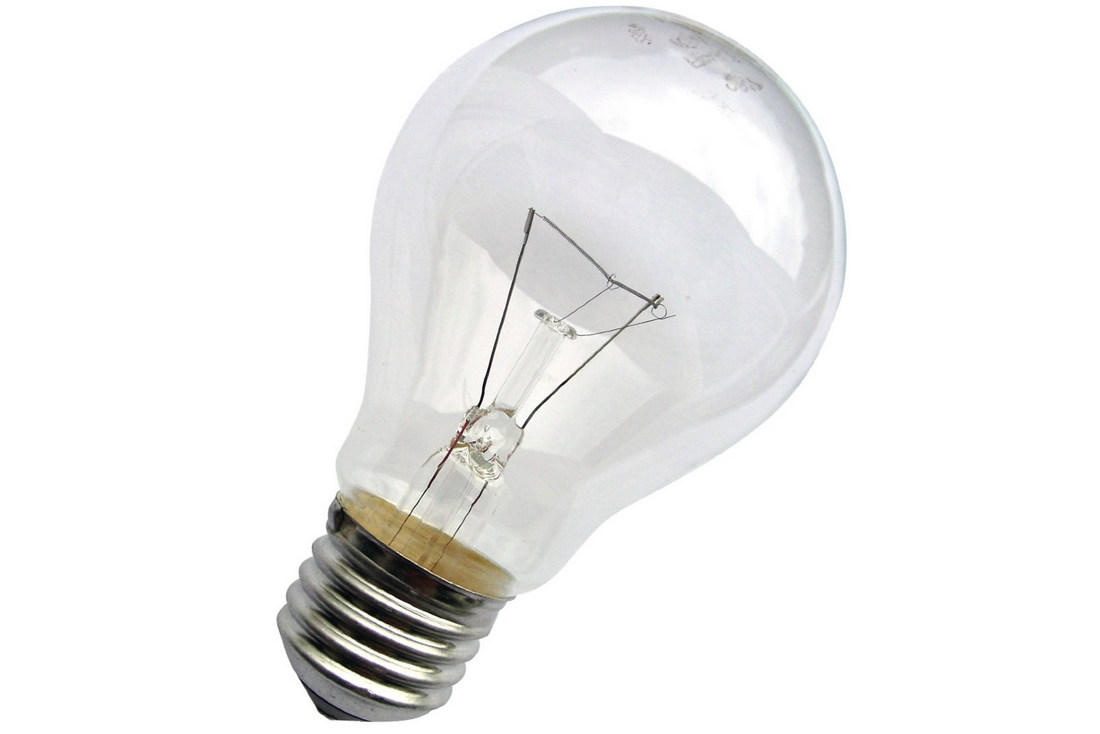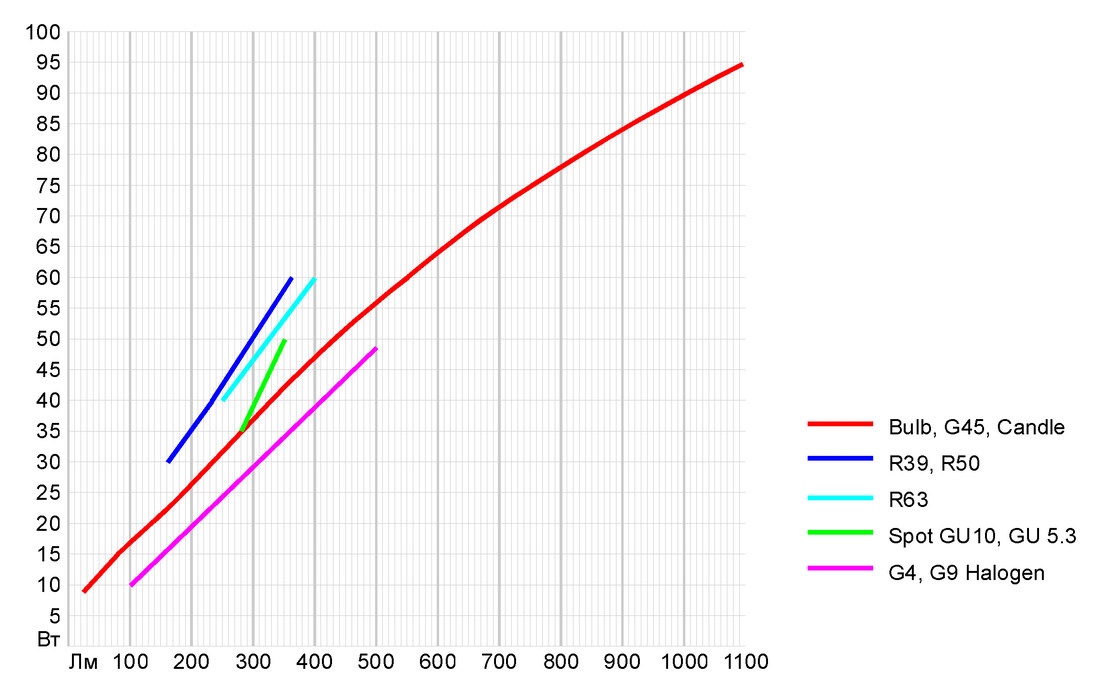LED lamps: try to figure out the equivalent
Most buyers of LED lamps are oriented on the equivalent of incandescent lamps. They roughly represent how a 40- or 60-watt lamp shines and selects LED lamps based on this. And here miracles begin. All manufacturers specify completely different equivalent values. Lamptest.ru has collected data for more than 500 LED lamps and the picture looks very funny.

For conventional lamp-pears manufacturers indicate the equivalent of 60 W with the values of the luminous flux: 450, 500, 510, 525, 530, 540, 560, 570, 580, 600, 620, 630, 650, 680, 700, 720, 807 Lm. A good run almost doubled!
')
For the "candles" is still more fun. Manufacturers indicate the equivalent of 40 watts for luminous flux from 250 to 480 lm.
If you take, for example, the luminous flux of 470 Lm, you can see that different manufacturers specify for it the equivalent of 40, 45, 60 and even 75 watts.
I note that all this is not measured values, but the data that manufacturers give on packages of lamps.
So where is the truth? And what the correspondence of the light flux and the equivalent is true?
It would seem that a simple task turns out to be far from simple. I measured the parameters of several dozen incandescent bulbs and came to the following conclusions:
1. The luminous flux of incandescent lamps is highly dependent on the voltage in the network. For example, an OSRAM 60 W lamp gives 710 Lm, indicated on its package, at a voltage of 230 V, and at a voltage of 220 V, it gives only 616 Lm.
2. The vast majority of incandescent bulbs of any brands, even at a nominal voltage of 230 V, give a significantly lower luminous flux than specified by the manufacturer. For example, the lamp GE Classic A50 / 60W-230V-F-E27 at 230 V gives only 556 Lm, and Philips A55 frosted 230V E27 ES 60W - 614 Lm, although both lamps have a luminous flux of 710 Lm.
3. The dependence of the luminous flux on the power consumption is very different for different types of lamps. Pears, candles and balls have a ratio of 9-14 Lm / W, for mirror lamps R39, R50, R63 6.4-7.7 Lm / W, for spots GU10 and GU5.3 - 6-9 Lm / W, for microtubes G4 and G9 - 9.2-10.3 Lm / W.
4. Come across incandescent bulbs that work with a glow. Such lamps give more light than stated, but not for a long time. They can be easily identified by a color temperature much higher than that stated.
There are several standards for determining the equivalent, but they are all far from reality. For example, in one of the European standards it is considered that 60 W is 806 Lm, only a single 60-watt lamp will never give that much light in real conditions.
I believe that the equivalent should be determined on the basis of conditions as close to real as possible. According to the standard, we have 230 volts in our network, but in most houses the voltage is closer to 220 V. When buying LED lamps, we want to replace them with incandescent bulbs, which are sold in stores, rather than ideal lamps, which give just as much light as is written on the package which buy is unlikely to succeed. Therefore, to determine equivalents, I take medium incandescent lamps (not the worst and not the best in terms of the luminous flux) operating at a voltage of 220 volts.
I got the following equivalent values:
Pears, balls, candles:
15 W - 80 Lm
25 W - 180 Lm
40 W - 330 Lm
60 W - 550 Lm
75 W - 750 Lm
95 W - 1100 Lm
Mirror lamps R39, R50:
30 W - 160 Lm
40 W - 230 Lm
60 W - 360 Lm
Mirror lamps R63:
40 W - 250 Lm
60 W - 400 Lm
Spotlights GU10, GU5.3:
35 W - 280 Lm
50 W - 360 Lm
Halogen micro tubes G4, G9:
10 W - 100 Lm
48 W - 500 Lm

Of course, data is not enough, but what is, that is.
Since the equivalent for the reasons described above cannot be exact, I think that on the site it should be rounded to 5 watts. Perhaps the easiest way to make a table with ranges of values of the luminous flux for each equivalent and each type of lamp.
The data on lamptest.ru is loaded from a CSV file obtained from the Excel source file. It would be very cool to write to Excel a grand formula that, depending on the type of lamp and the measured luminous flux, counts the value in the equivalent field.
If you know Excel well and are ready to write such a formula, I will be very grateful. The source data file is here: lamptest.ru/led.xls

For conventional lamp-pears manufacturers indicate the equivalent of 60 W with the values of the luminous flux: 450, 500, 510, 525, 530, 540, 560, 570, 580, 600, 620, 630, 650, 680, 700, 720, 807 Lm. A good run almost doubled!
')
For the "candles" is still more fun. Manufacturers indicate the equivalent of 40 watts for luminous flux from 250 to 480 lm.
If you take, for example, the luminous flux of 470 Lm, you can see that different manufacturers specify for it the equivalent of 40, 45, 60 and even 75 watts.
I note that all this is not measured values, but the data that manufacturers give on packages of lamps.
So where is the truth? And what the correspondence of the light flux and the equivalent is true?
It would seem that a simple task turns out to be far from simple. I measured the parameters of several dozen incandescent bulbs and came to the following conclusions:
1. The luminous flux of incandescent lamps is highly dependent on the voltage in the network. For example, an OSRAM 60 W lamp gives 710 Lm, indicated on its package, at a voltage of 230 V, and at a voltage of 220 V, it gives only 616 Lm.
2. The vast majority of incandescent bulbs of any brands, even at a nominal voltage of 230 V, give a significantly lower luminous flux than specified by the manufacturer. For example, the lamp GE Classic A50 / 60W-230V-F-E27 at 230 V gives only 556 Lm, and Philips A55 frosted 230V E27 ES 60W - 614 Lm, although both lamps have a luminous flux of 710 Lm.
3. The dependence of the luminous flux on the power consumption is very different for different types of lamps. Pears, candles and balls have a ratio of 9-14 Lm / W, for mirror lamps R39, R50, R63 6.4-7.7 Lm / W, for spots GU10 and GU5.3 - 6-9 Lm / W, for microtubes G4 and G9 - 9.2-10.3 Lm / W.
4. Come across incandescent bulbs that work with a glow. Such lamps give more light than stated, but not for a long time. They can be easily identified by a color temperature much higher than that stated.
There are several standards for determining the equivalent, but they are all far from reality. For example, in one of the European standards it is considered that 60 W is 806 Lm, only a single 60-watt lamp will never give that much light in real conditions.
I believe that the equivalent should be determined on the basis of conditions as close to real as possible. According to the standard, we have 230 volts in our network, but in most houses the voltage is closer to 220 V. When buying LED lamps, we want to replace them with incandescent bulbs, which are sold in stores, rather than ideal lamps, which give just as much light as is written on the package which buy is unlikely to succeed. Therefore, to determine equivalents, I take medium incandescent lamps (not the worst and not the best in terms of the luminous flux) operating at a voltage of 220 volts.
I got the following equivalent values:
Pears, balls, candles:
15 W - 80 Lm
25 W - 180 Lm
40 W - 330 Lm
60 W - 550 Lm
75 W - 750 Lm
95 W - 1100 Lm
Mirror lamps R39, R50:
30 W - 160 Lm
40 W - 230 Lm
60 W - 360 Lm
Mirror lamps R63:
40 W - 250 Lm
60 W - 400 Lm
Spotlights GU10, GU5.3:
35 W - 280 Lm
50 W - 360 Lm
Halogen micro tubes G4, G9:
10 W - 100 Lm
48 W - 500 Lm

Of course, data is not enough, but what is, that is.
Since the equivalent for the reasons described above cannot be exact, I think that on the site it should be rounded to 5 watts. Perhaps the easiest way to make a table with ranges of values of the luminous flux for each equivalent and each type of lamp.
The data on lamptest.ru is loaded from a CSV file obtained from the Excel source file. It would be very cool to write to Excel a grand formula that, depending on the type of lamp and the measured luminous flux, counts the value in the equivalent field.
If you know Excel well and are ready to write such a formula, I will be very grateful. The source data file is here: lamptest.ru/led.xls
Source: https://habr.com/ru/post/390711/
All Articles